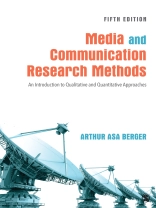This step-by-step introduction to conducting media and communication research offers practical insights along with the author’s signature lighthearted style to make discussion of qualitative and quantitative methods easy to comprehend. The Fifth Edition of Media and Communication Research Methods includes a new chapter on discourse analysis; expanded discussion of social media, including discussion of the ethics of Facebook experiments; and expanded coverage of the research process with new discussion of search strategies and best practices for analyzing research articles. Ideal for research students at both the graduate and undergraduate level, this proven book is clear, concise, and accompanied by just the right number of detailed examples, useful applications, and valuable exercises to help students to understand, and master, media and communication research.
Tabla de materias
Preface to the Fifth Edition
Acknowledgments
Introduction
Round Up the Usual Suspects
Applying the Focal Points Model to Media
How I Became a Man Without Quantities
Data Man Versus Data-Free Man
Kinds of Questions Researchers Ask
Conclusions of a Man Without Quantities, Who Is Also a Practicing Theoretician
Introduction: Applications and Exercises
PART I. GETTING STARTED
1. What Is Research?
We All Do Research, All the Time
Scholarly Research Is Different From Everyday Research
Cultural Studies and Research
Nietzsche on Interpretation
Problem of Certainty
Diachronic and Synchronic Research
The Way the Human Mind Works
Overt and Covert Oppositions
Thinking, Fast and Slow
Quantity and Quality in Media Research
Media and Communication
Why a Book That Teaches Both Methodologies?
Considering Research Topics
What Is Research? Applications and Exercises
Conclusions
Further Reading
2. The Research Process
Search Strategies
Sources of Information
How to Read Analytically
Critical Thinking
Critical Thinking as Defined by the National Council for Excellence in Critical Thinking, 1987
Doing a Literature Review
Primary and Secondary Research Sources
Searching on the Internet (or “Find the Info If You Can!”)
Using the Internet to Conduct Research
Analyzing Methodology in Research Articles
The Research Process: Applications and Exercises
Conclusions
Further Reading
PART II. METHODS OF TEXTUAL ANALYSIS
3. Semiotic Analysis
Saussure’s Division of Signs Into Signifiers and Signifieds
Semiotics of Blondeness
Semiotics and Society
Peirce’s Trichotomy: Icon, Index, and Symbol
Allied Concepts
Michel Foucault on Codes and Cultural Change
Marcel Danesi on Codes and Culture
Clotaire Rapaille on Culture Codes
Semiotics in Society: A Reprise
Syntagmatic Analysis of Texts
Paradigmatic Analysis of Texts
Applications of Semiotic Theory
Paul Ekman on Facial Expression
Semiotics: Applications and Exercises
Conclusions
Further Reading
4. Rhetorical Analysis
Aristotle on Rhetoric
Rhetoric and the Mass Media
A Brief Note on the Communication Process
Certeau on Subversions by Readers and Viewers
Applied Rhetorical Analysis
A Miniglossary of Common Rhetorical Devices
Other Considerations When Making Rhetorical Analyses
A Sample Rhetorical Analysis: A La Mer Advertisement
Rhetorical Analysis of the Visual Image
Images in Narrative Texts
Gangsta Rap and American Popular Culture
Rhetorical Analysis: Applications and Exercises
Conclusions
Further Reading
5. Ideological Criticism
Mannheim’s Ideology and Utopia
Defining Ideology
Marxist Criticism
Roland Barthes on Mythologies
The Problem of Hegemony
The Base and the Superstructure, False Consciousness, and the “Self-Made Man and Woman”
Post-Soviet Marxist Criticism
Society of the Spectacle
Basic Ideas in Marxist Criticism
A Marxist Interpretation of the Fidji “Snake” Advertisement
John Berger on Glamour
Identity Politics
Feminist Criticism of Media and Communication
The Social Conception of Knowledge
Phallocentric Theory: The Physical Basis of Male Domination
Political Cultures, the Media, and Communication
Pop Cultural and Media Preferences of the Four Political Cultures
Marxist Perspectives on Social Media
A Preview of Critical Discourse Analysis
Ideological Criticism: Applications and Exercises
Conclusions
Further Reading
6. Psychoanalytic Criticism
Freud’s Contribution
Smartphones and the Psyche: Applying the Theories of Erik Erikson
Smartphones and the Self
Neuropsychoanalysis: Freud and Neuroscience
Jungian Theory
Psychoanalytic Criticism: Applications and Exercises
Conclusions
Further Reading
7. Discourse Analysis
Defining Discourse Analysis
Teun A. van Dijk on Discourse Analysis
Spoken and Written Discourse
Styles and Written Discourse
Political Ideologies and Discourse Analysis
Critical Discourse Analysis
Advertising and Critical Discourse Analysis
Multimodal Discourse Analysis
Multimodal Critical Discourse Analysis
Fashion and Discourse Analysis
A Multimodal Critical Discourse Analysis of an Advertisement
Discourse Analysis: Applications and Exercises
Conclusions
Further Reading
PART III. QUALITATIVE RESEARCH METHODS
8. Interviews
The Prisoner Interviews Number Two
What Is an Interview?
Four Kinds of Research Interviews
Why We Use Interviews
How to Interview People
Kinds of Questions
Questions Investigative Reporters Ask
The Structure of Conversations and Interviews
Transcribing Recorded Interviews
Making Sense of Transcribed Interviews
Coding
Problems With Interview Material
Interviews: Applications and Exercises
Conclusions
Further Reading
9. Historical Analysis
What Is History?
History as Metadiscipline or Specialized Subject
Is History Objective, Subjective, or a Combination of the Two?
The Importance of Fernand Braudel
Kinds of Historical Research
The Problem of Writing History
The Problem of Meaning
Historical Periods
Baudrillard and Jameson on Postmodernism
Postmodernism and Historiography
The Historical and the Comparative Approach
History Is an Art, Not a Science
Doing Historical Research
Historical Analysis: Applications and Exercises
Conclusions
Further Reading
10. Ethnomethodological Research
Defining Ethnomethodology
Garfinkel’s Ingenious and Mischievous Research
Norbert Wiley’s Interesting Perspective on Harold Garfinkel
Using Ethnomethodology in Media and Communication Research
Metaphors and Motivation
Love Is a Game
Humorists as Code Violators
Techniques of Humor
Ethnomethodology and the Communication Process
Ethnomethodological Research: Applications and Exercises
Conclusions
Further Reading
11. Participant Observation
Defining Participant Observation
Significant Considerations When Doing Participant Observation
A Case Study of Participant Observation: Readers of Romance Novels
Problems With Participant Observation
Benefits of Participant Observation Studies
Making Sense of Your Findings
Writing Up a Participant Observation Study
An Ethical Dilemma
Ethics and Research Involving Humans
Participant Observation: Applications and Exercises
Conclusions
Further Reading
PART IV. QUANTITATIVE RESEARCH METHODS
12. Content Analysis
Defining Content Analysis
Why We Make Content Analyses
Methodological Aspects of Content Analysis
Aspects of Violence
Advantages of Content Analysis as a Research Method
Difficulties in Making Content Analyses
Content Analysis Step-By-Step
Content Analysis: Applications and Exercises
A Cautionary Note From Denis Mc Quail
Conclusions
Further Reading
13. Surveys
Defining Surveys
Kinds of Surveys: Descriptive and Analytic
The VALS Typology Survey
Methods of Data Collection
Advantages of Survey Research
Problems With Surveys
Surveys and the 2012 Presidential Election
Surveys and the 2016 Presidential Election
A Note on Media Usage Surveys: Shares and Ratings
Open-Ended and Closed-Ended Survey Questions
Writing Survey Questions
Making Pilot Studies to Pretest Surveys
Conducting Online Surveys
Samples
Obtaining Random Samples
Evaluating Survey Accuracy
Surveys: Applications and Exercises
Conclusions
Further Reading
14. Experiments
Everyday Experimentation
Defining Experiments
The Structure of an Experiment
The Hawthorne Effect
Advantages of Experiments
Disadvantages of Experiments
The “Black Rats” Case and Experimental Fraud
A Checklist on Experimental Design
What’s an Experiment and What Isn’t?
Ethics and the Facebook Experiment
Experiments: Applications and Exercises
Conclusions
Further Reading
15. A Primer on Descriptive Statistics
Levels of Measurement
Descriptive Statistics
Measures of Central Tendency
Measures of Dispersion
The Normal or Bell-Shaped Curve
The Problem With Ratings
A Cautionary Note on Statistics
Using Statistics to Support a Claim
Statistics and Comparisons
Data on Media Use in America
Smartphones
The Problem of Interpretation
Statistics and Problems Caused by Definitions
Statistics: Applications and Exercises
Conclusions
Further Reading
PART V. PUTTING IT ALL TOGETHER
16. Nineteen Common Thinking Errors
Common Fallacies
Conclusions
Further Reading
17. Writing Research Reports
Keeping a Journal
A Trick for Organizing Reports
Outlines, First Drafts, and Revisions
Writing Research Reports
The IMRD Structure of Quantitative Research Reports
Writing Correctly: Avoiding Some Common Problems
Academic Writing Styles
A Checklist for Planning Research and Writing Reports
Conclusions
Further Reading
Glossary
References
Name Index
Subject Index
About the Author
Sobre el autor
Arthur Asa Berger is Professor Emeritus of Broadcast and Electronic Communication Arts at San Francisco State University, where he taught between 1965 and 2003. He has published more than 100 articles, numerous book reviews, and more than 60 books. Among his latest books are the third edition of Media and Communication Research Methods: An Introduction to Qualitative and Quantitative Approaches (2013), The Academic Writer’s Toolkit: A User’s Manual (2008), What Objects Mean: An Introduction to Material Culture (2009), Bali Tourism (2013), Tourism in Japan: An Ethno-Semiotic Analysis (2010), The Culture Theorist’s Book of Quotations (2010), and The Objects of Our Affection: Semiotics and Consumer Culture (2010). He has also written a number of academic mysteries such as Durkheim is Dead: Sherlock Holmes is Introduced to Sociological Theory (2003) and Mistake in Identity: A Cultural Studies Murder Mystery (2005). His books have been translated into eight languages and thirteen of his books have been translated into Chinese.












